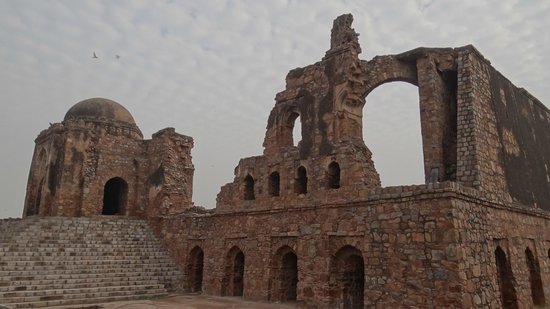Feroz Shah Kotla
Balmiki Basti, Vikram Nagar, New Delhi -110 002

The Feroz Shah Kotla was a fortress built by Sultan Feroz Shah Tughlaq to house his version of Delhi city called Ferozabad. A pristine polished sandstone pillar from the 3rd century B.C. rises from the palace’s crumbling remains, one of many pillars of Ashoka left by the Maurtan emperor; it was moved from Pong Ghati Ambala, Punjab (currently in Haryana) to Delhi under orders of Firoz Shah Tughlaq of Delhi Sultanate, and re-erected in its present location in 1356.
The original inscription on the obelisk is primarily in Brahmi script but language was prakrit, with some Pali and Sanskrit added later. The inscription was successfully translated in 1837 by James Prinsep. This and other ancient lats (pillars, obelisk) have earned Firoz Shah Tughlaq and Delhi Sultanate fame for its architectural patronage. Other than the Ashokan Pillar, the Fort complex also houses the Jami Masjid (Mosque), a Baoli and a large garden complex.
Feroz Shah Tughlaq (r. 1351–88), the Sultan of Delhi, established the fortified city of Firuzabad in 1354, as the new capital of the Delhi Sultanate , and included in it the site of the present Feroz Shah Kotla. Kotla literally means fortress or citadel. The 13.1 metres high column, made of polished sandstone and dating from the 3rd Century BC, was brought from Ambala in 14th century under orders of Feroz Shah. It was installed on a three-tiered arcaded pavilion near the congregational mosque, inside the Sultanate’s fort. In centuries that followed, much of the structure and buildings near it were destroyed as subsequent rulers dismantled them and reused the spolia as building materials.
Jama Masjid
Jami Masjid is one of the most ancient and largest surviving mosque and monument, still in use. Architecturally it was built on a series of underground cells and made of quartzite stone, covered with lime stone. It is surrounded by a large courtyard with cloisters and a Prayer Hall. The Prayer Hall now in complete ruins, was once used by the Royal Ladies. The mosque and its architecture is an example of Tughluq architecture.
The entrance of Jama Masjid lies on the northern side. It is connected by a causeway to the pyramidal structure of the Ashokan Pillar. This mosque was visited by Sultan Timur in 1398 AD to say his prayers. He was spellbound by its beauty and constructed a mosque in Samarkand in Iran imitating the design of this Masjid. This mosque is also known to be the place where Imad ul Mulk, a Mughal Prime Minister, was murdered by his own Emperor Alamgir Sani in 1759 AD.
Ashokan Pillar
The Ashokan Pillar that lies within Feroz Shah Kotla is perfectly placed towards the north of Jama Masjid [Mosque]. The Pillar was first erected by King Ashoka between 273 and 236 BC in Topra, Ambala, Haryana. In fact there was another Ashokan Pillar, that is seen installed near the Hindu Rao Hospital, also erected by King Ashoka in Meerut. This pillar, however was unfortunately broken into five pieces after it was damaged during an explosion. The pillar was neglected for a century up till 1838, when Hindu Rao took charge to transfer the Ashokan Pillar’s broken pieces to Kolkata’s Asiatic Society. Within a year, the structure was put together and re-established.
Both the Ashokan Pillars were carefully wrapped with cotton silk and were kept on a bed of reed made of raw silk. These were hence transported on a massive carriage attached with 42 wheels and drawn meticulously by 200 men from their original places to Delhi by Feroz Shah Tughlaq to avoid any damage during the journey. Upon reaching Delhi, they were then transported on huge boats to their final destination, one within Feroz Shah Kotla and the other on the ridge near Delhi University and Bara Hindu Rao Hospital.
Baoli (The Well)
The circular Baoli, which means ‘step well’, lies towards the north western side of the Ashokan Pillar. It lies in the heart of a large garden constructed in the form of subterranean apartments and a large underground canal built on its eastern side through which the water runs into the well. This Baoli served as a summer retreat for the Royalties, where they spent time cooling off and bathing in the water of this well.[11] The baoli lies locked and in ruins but is still used to water the gardens within the Firoz Shah Kotla complex. One would not be able to see much of the insides of the baoli. You can however climb up the pyramidical monument where the Asokan pillar in installed for an elevated view. However, a clear view of the baoli is still not possible. The guards at the complex maintain that the baoli has remained locked since a suicide incident in early 2014.
Source : Wikipedia
https://www.youtube.com/watch?v=GNVqlQyz8og
https://www.youtube.com/watch?v=19YJvUP9AVs
https://www.youtube.com/watch?v=9PPnG4Emszk
Reviews
Timings : Sunrise to Sunset
Entry Fee : Indian Nationals Rs.5/- and Foreign Nationals Rs. 100/-


Rate this article